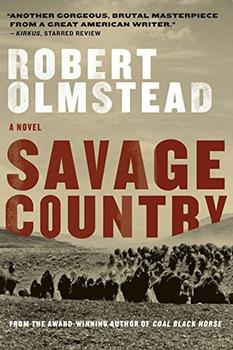Summary | Excerpt | Reviews | Beyond the Book | Read-Alikes | Genres & Themes | Author Bio

A Novel
by Robert OlmsteadThis article relates to Savage Country
 It's not mentioned specifically in Robert Olmstead's Savage Country, but his references to settlers driven off the land by crop failures, drought, and other factors might be seen as one of the adverse influences of 1862's Homestead Act, probably the most significant factor in the expansion of the United States across the continent.
It's not mentioned specifically in Robert Olmstead's Savage Country, but his references to settlers driven off the land by crop failures, drought, and other factors might be seen as one of the adverse influences of 1862's Homestead Act, probably the most significant factor in the expansion of the United States across the continent.
Signed into law by Abraham Lincoln, the Act offered 160 acres of "public land" (meaning federal territory) to any head of household. The cost? Eighteen dollars. But there was a condition: "Each homesteader had to live on the land, build a home, make improvements and farm for 5 years before they were eligible to prove up."
 Olmstead's novel notes that many of those "homes" on a would-be settler's land were "soddys," homes built from earthen blocks topped by a sod roof. The vast open prairies of the west provided little other building material. Forests were nonexistent. Trees were rare. The "sod busters" (ranchers' term for settlers) began to plow up the prairie paradise, soil so productive that the grasses often grew six feet tall, high enough that grass-covered open spaces could be a danger to children.
Olmstead's novel notes that many of those "homes" on a would-be settler's land were "soddys," homes built from earthen blocks topped by a sod roof. The vast open prairies of the west provided little other building material. Forests were nonexistent. Trees were rare. The "sod busters" (ranchers' term for settlers) began to plow up the prairie paradise, soil so productive that the grasses often grew six feet tall, high enough that grass-covered open spaces could be a danger to children.
In the late 19th century, more than seven million acres of public land were distributed to homesteaders. Later, from 1911 to 1915, more than 42.5 million acres were homesteaded. The Act was repealed in 1976, although homesteading was allowed to continue in Alaska until 1986.
 The Act made the United States "the breadbasket of the world" as it opened millions of acres to settlement and farming. However, the Act, combined with Mother Nature, also created the Dust Bowl. Thousands upon thousands of acres of grassland prairie had been plowed to plant hard winter wheat and other crops. During periods of drought and minimal rainfall, as the land lay cut and fallow, topsoil bled away.
The Act made the United States "the breadbasket of the world" as it opened millions of acres to settlement and farming. However, the Act, combined with Mother Nature, also created the Dust Bowl. Thousands upon thousands of acres of grassland prairie had been plowed to plant hard winter wheat and other crops. During periods of drought and minimal rainfall, as the land lay cut and fallow, topsoil bled away.
Two verses of Woody Guthrie's song "Dust Storm Disaster" tell the story:
The storm took place at sundown, it lasted through the night,
When we looked out next morning, we saw a terrible sight.
We saw outside our window where wheat fields they had grown
Was now a rippling ocean of dust the wind had blown.
It covered up our fences, it covered up our barns,
It covered up our tractors in this wild and dusty storm.
We loaded our jalopies and piled our families in,
We rattled down that highway to never come back again.
 Modern farming techniques, including irrigation, have ameliorated many of the factors that brought on the Dust Bowl, and the Great Plains continue to be a source of American agricultural abundance. Today, things are poised to change yet again, with depleted aquifers and climate change driving further evolution in prairie farming techniques.
Modern farming techniques, including irrigation, have ameliorated many of the factors that brought on the Dust Bowl, and the Great Plains continue to be a source of American agricultural abundance. Today, things are poised to change yet again, with depleted aquifers and climate change driving further evolution in prairie farming techniques.
1898 North Dakota Sod Hut
Homestead application, courtesy of www.archives.gov
Land advertisement, courtesy of chnm.gmu.edu
Family pursuing land, courtesy of www.archives.gov
Filed under People, Eras & Events
![]() This "beyond the book article" relates to Savage Country. It originally ran in September 2017 and has been updated for the
September 2018 paperback edition.
Go to magazine.
This "beyond the book article" relates to Savage Country. It originally ran in September 2017 and has been updated for the
September 2018 paperback edition.
Go to magazine.
Your guide toexceptional books
BookBrowse seeks out and recommends the best in contemporary fiction and nonfiction—books that not only engage and entertain but also deepen our understanding of ourselves and the world around us.